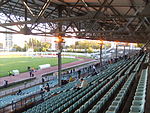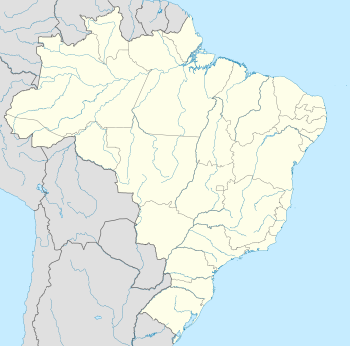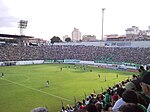
A | B | C | D | E | F | G | H | CH | I | J | K | L | M | N | O | P | Q | R | S | T | U | V | W | X | Y | Z | 0 | 1 | 2 | 3 | 4 | 5 | 6 | 7 | 8 | 9
This article is regarding the stadiums used for FIFA World Cup.
Stadium requirements
FIFA has had strict stadium guideline requirements since at least 2001.[1] Stadiums must have a capacity of at least 40,000, stadiums hosting quarter-finals or semi-finals must have a minimum of 60,000 and those hosting the opening ceremony or final must have a capacity of at least 80,000.[2] In addition, stadiums must have a minimum number of television camera stands and media areas and also be free of advertising throughout the World Cup. This includes stadium names – for instance, during the 2006 World Cup, German stadiums such as Allianz Arena were renamed "FIFA World Cup Stadium – Munich" for licensing reasons.[3]
Statistics
- Most matches hosted: Estadio Azteca (19 – 10 matches in 1970 and 9 matches in 1986)
- Most opening matches hosted: Estadio Azteca (2 – 1970 and 1986)
- Most finals hosted: Estadio Azteca (2 – 1970 and 1986), Maracanã Stadium (2 – 1950 (final match of final group stage) and 2014)
- Highest attendance: Maracanã Stadium (173,850 – final match in 1950)[4]
| Year | Host | Cities | Stadiums |
|---|---|---|---|
| 1930 | 1 | 3 | |
| 1934 | 8 | 8 | |
| 1938 | 10 | 10 [nb 1] | |
| 1950 | 6 | 6 | |
| 1954 | 6 | 6 | |
| 1958 | 12 | 12 | |
| 1962 | 4 | 4 | |
| 1966 | 7 | 8 | |
| 1970 | 5 | 5 | |
| 1974 | 9 | 9 | |
| 1978 | 5 | 6 | |
| 1982 | 14 | 17 | |
| 1986 | 11 | 12 | |
| 1990 | 12 | 12 | |
| 1994 | 9 | 9 | |
| 1998 | 10 | 10 | |
| 2002 | 20 | 20 [nb 2] | |
| 2006 | 12 | 12 | |
| 2010 | 9 | 10 | |
| 2014 | 12 | 12 | |
| 2018 | 11 | 12 | |
| 2022 | 5 | 8 | |
| 2026 [nb 3] |
16 | 16 [nb 4] |
- ^ 11 stadiums in 11 cities were planned, but the only match in Lyon was cancelled after Austria withdrew.
- ^ 10 stadiums in 10 cities in South Korea, 10 stadiums in 10 cities in Japan.
- ^ Future event, changes may occur.
- ^ 11 stadiums in 11 cities in the United States, 3 stadiums in 3 cities in Mexico, 2 stadiums in 2 cities in Canada.
Stadiums by tournament
1930
All 1930 FIFA World Cup matches took place in Montevideo. Three stadiums were used: Estadio Centenario, Estadio Pocitos, and Estadio Parque Central. The Estadio Centenario was built both for the tournament and as a celebration of the centenary of Uruguayan independence. Designed by Juan Scasso,[5] it was the primary stadium for the tournament, referred to by Rimet as a "temple of football".[6] With a capacity of 90,000, it was the largest football stadium outside the British Isles.[7] The stadium hosted 10 of the 18 matches, including both semi-finals and the final. However, a rushed construction schedule and delays caused by the rainy season meant the Centenario was not ready for use until five days into the tournament.[8] Early matches were played at smaller stadiums usually used by Montevideo football clubs Nacional and Peñarol, the 20,000 capacity Parque Central and the Pocitos.
|
List of FIFA World Cup stadiums (Uruguay) |
Montevideo | ||
|---|---|---|---|
| Estadio Centenario | Estadio Gran Parque Central | Estadio Pocitos | |
| 34°53′40.38″S 56°9′10.08″W / 34.8945500°S 56.1528000°W | 34°54′4″S 56°9′32″W / 34.90111°S 56.15889°W | 34°54′18.378″S 56°9′22.42″W / 34.90510500°S 56.1562278°W | |
| Capacity: 90,000 | Capacity: 20,000 | Capacity: 1,000 | |

|

|

| |
1934
During the 1934 FIFA World Cup the number of supporters travelling from other countries was higher than at any previous football tournament, including 7,000 from the Netherlands and 10,000 each from Austria and Switzerland.[9]
| Milan | Bologna | Rome | Florence | |
|---|---|---|---|---|
| Stadio San Siro | Stadio Littoriale | Stadio Nazionale PNF | Stadio Giovanni Berta | |
| Capacity: 55,000 | Capacity: 50,100 | Capacity: 47,300 | Capacity: 47,290 | |

|

|

|

| |
| Naples | Genoa | Turin | Trieste | |
| Stadio Giorgio Ascarelli | Stadio Luigi Ferraris | Stadio Benito Mussolini | Stadio Littorio | |
| Capacity: 40,000 | Capacity: 36,703 | Capacity: 28,140 | Capacity: 8,000 | |

|

|

|

|
1938
Ten cities were planned to host the 1938 FIFA World Cup tournament; of these, all hosted matches except Lyon, which did not due to Austria's withdrawal.
| Colombes (suburbs of Paris) | Paris | Marseille | ||
|---|---|---|---|---|
| Stade Olympique de Colombes | Parc des Princes | Stade Vélodrome | ||
| Capacity: 60,000 | Capacity: 48,712 | Capacity: 48,000 | ||

|

|

| ||
| Lyon | Toulouse | Bordeaux | Strasbourg | |
| Stade Gerland (only match cancelled) |
Stade du T.O.E.C. (in the old Parc des Sports), initially planned to the new stadium again in building (in the new Parc des Sports) |
Parc Lescure | Stade de la Meinau | |
| Capacity: 40,500 | Capacity: 15,000 | Capacity: 34,694 | Capacity: 30,000 | |

|

|

| ||
| Le Havre | Reims | Lille | Antibes | |
| Stade Municipal | Vélodrome Municipal | Stade Victor Boucquey | Stade du Fort Carré | |
| Capacity: 22,000 | Capacity: 21,684 | Capacity: 15,000 | Capacity: 7,000 | |

|

|

|

| |
1950
Six venues in six cities around Brazil hosted the 22 matches played for the 1950 FIFA World Cup. The Maracanã in the then-capital of Rio de Janeiro hosted eight matches, including all but one of the host's matches, including the Maracanazo match in the second round robin group that decided the winners of the tournament. The Pacaembu stadium in São Paulo hosted six matches; these two stadiums in São Paulo and Rio were the only venues that hosted the second round robin matches. The Estádio Sete de Setembro in Belo Horizonte hosted three matches, the Durival de Britto stadium in Curitiba and the Eucaliptos stadium in Porto Alegre each hosted two matches, and the Ilha do Retiro stadium in far-away Recife only hosted one match.







